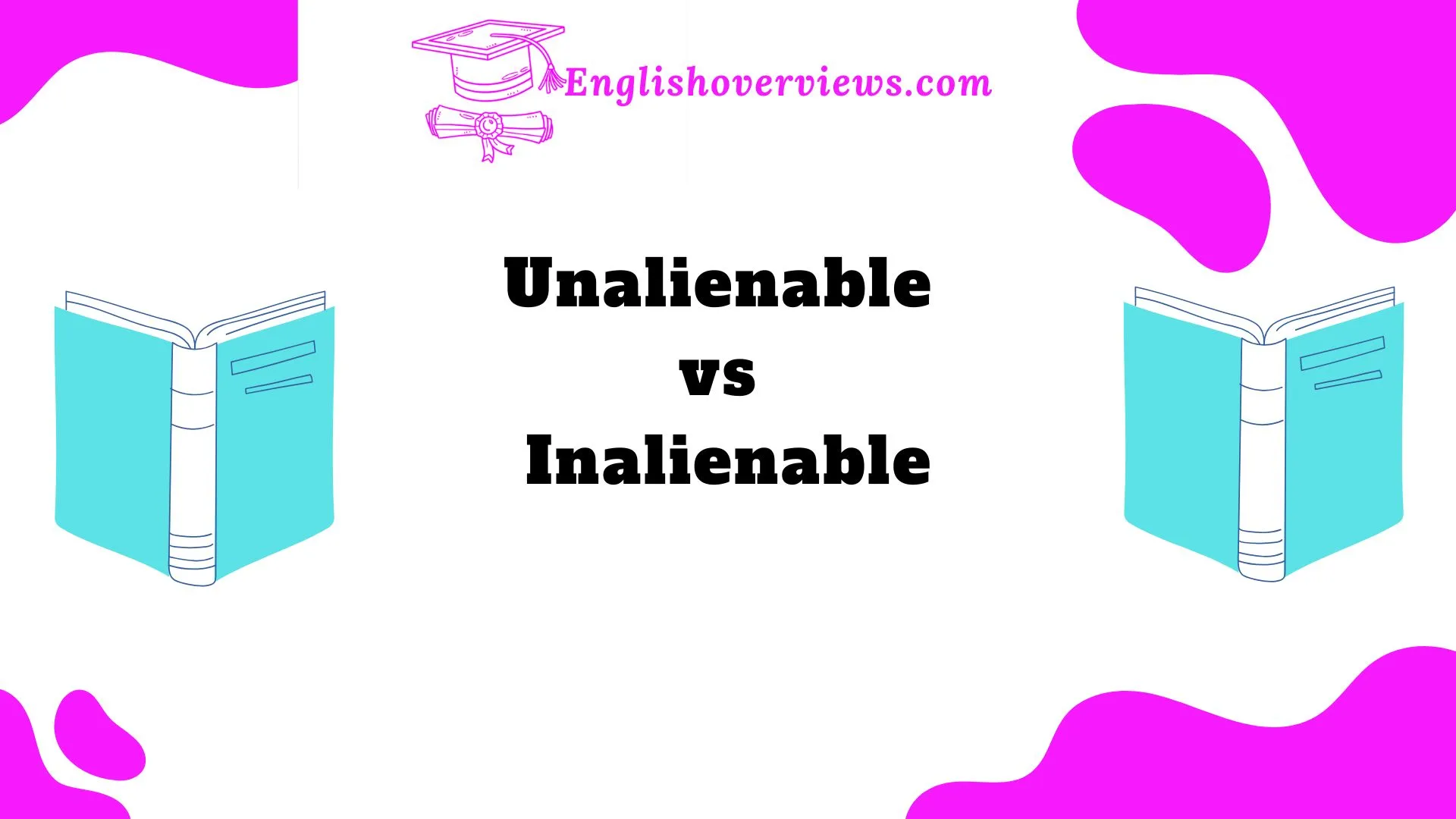In the world of legal and historical language, few terms spark as much confusion and debate as unalienable and inalienable. Both words frequently appear in discussions about human rights, especially when referencing America’s Declaration of Independence.
But are they the same? Do they carry distinct meanings, or has their usage evolved into something interchangeable?
This article dives into the history, definitions, and modern relevance of these two terms. We’ll explore their origins, their use in pivotal moments like the drafting of the Declaration, and their broader cultural significance.
By the end, you’ll have a clear understanding of whether unalienable and inalienable truly differ and why it matters today.
Let’s dig in.
Understanding the Terms: Definitions and Etymology
To truly grasp the difference between unalienable and inalienable, we need to start with their definitions and roots. Both words stem from the Latin term alienare, which means “to transfer ownership” or “to make another’s.” Adding the prefix “un-” or “in-” gives these words the opposite meaning: something unable to be transferred or taken away.
Key Definitions
- Unalienable: Something that cannot be sold, transferred, or surrendered under any condition.
- Inalienable: Something that cannot be taken away but might be voluntarily waived under specific circumstances.
Origins
- The term unalienable gained prominence during the 18th century, especially in legal and philosophical contexts.
- Inalienable emerged later, becoming a more modern usage.
- Both terms have been used in law, literature, and everyday language, often interchangeably.
Here’s a quick comparison table to highlight the slight nuances:
| Term | Origin | Meaning | Usage Example |
| Unalienable | 18th century | Rights that cannot be transferred at all. | Declaration of Independence |
| Inalienable | 19th century onward | Rights that can’t be taken, but might be waived voluntarily. | Modern legal discussions |
The Declaration of Independence: Unalienable vs. Inalienable
The phrase “unalienable Rights” is one of the most famous lines in American history, found in the Declaration of Independence. But was this word choice deliberate? Let’s unpack the details.
Jefferson’s Original Draft
- In Thomas Jefferson’s first draft, the term inalienable was used.
- During editing, unalienable replaced it. Scholars suggest this was due to the stylistic preferences of Jefferson’s contemporaries, such as John Adams.
Why “Unalienable”?
- At the time, unalienable was the more commonly used term in legal and philosophical writing.
- It also carried a stronger sense of immutability, aligning with the Enlightenment ideals that shaped the Declaration.
Tracing Historical Usage in Founding Documents
Both terms have appeared in key American documents and speeches over time. Let’s examine how they’ve been used.
Early Usage
- Federalist Papers: The term inalienable appeared more frequently here.
- State Constitutions: Varied usage, with some adopting unalienable and others using inalienable.
Examples
- Virginia Declaration of Rights (1776): Used “unalienable.”
- Massachusetts Constitution (1780): Preferred “inalienable.”
Key Takeaway
The usage of these terms was often dictated by regional preferences or the writing styles of individual authors, rather than a strict distinction in meaning.
Sentiments of the Era: Language of Liberty
The Enlightenment thinkers of the 18th century heavily influenced the phrasing in the Declaration. Philosophers like John Locke and Jean-Jacques Rousseau argued that certain rights like life, liberty, and property were natural rights. These rights were not granted by governments but inherent to all individuals.
Philosophical Influence
- John Locke referred to these rights as unalienable.
- Rousseau leaned more toward the term inalienable in his writings on the social contract.
Reflection in Language
The preference for unalienable in the Declaration reflects the emphasis on natural law as something immutable and inviolable.
Modern Usage: Trends in Language
Today, you’re more likely to encounter inalienable in modern texts and discussions. Why?
Linguistic Shift
- Inalienable gained popularity in the 19th and 20th centuries, likely due to its smoother sound in speech and writing.
- Unalienable, while still understood, is often viewed as archaic.
Modern Examples
- Legal Contexts: Terms like “inalienable rights” are standard in international human rights law.
- Speeches and Literature: Contemporary leaders often favor “inalienable” for its modern resonance.
Fact Check
- According to Google Ngram Viewer, the usage of “inalienable” overtook “unalienable” by the mid-1800s.
Are They Truly Interchangeable? A Linguistic and Legal Perspective
Linguistic Insights
- Most dictionaries define the two terms as synonyms.
- However, legal scholars note that unalienable carries a stronger sense of absolute non-transferability, while inalienable might allow for certain voluntary waivers.
Real-World Case Study
In legal debates, this distinction can be critical. For example:
- A case involving inalienable rights might consider whether an individual waived their rights under specific conditions.
- A case citing unalienable rights would argue those rights cannot be waived under any circumstance.
Drafts of the Declaration: Digging Deeper
The Declaration of Independence went through multiple drafts before its final version. Each draft offers insights into the thought process behind its language.
Changes Made
- First Draft: Used “inalienable.”
- Final Version: Edited to “unalienable.”
Why the Change?
Historians suggest that the change reflected the editorial influence of Adams and Franklin, who preferred the more traditional unalienable.
Presidential Perspectives: Evolution of Language in Speeches
Throughout history, U.S. presidents have used both terms in their speeches, often reflecting the political climate of their time.
Examples
- Abraham Lincoln: Often referred to unalienable rights in the context of abolition and liberty.
- John F. Kennedy: Favored inalienable in his discussions of civil rights.
Takeaway
While both terms are understood, their usage often mirrors the speaker’s stylistic preferences and the context of the message.
Synonyms and Related Concepts
In discussions of rights, unalienable and inalienable are part of a broader conversation about natural rights and human dignity.
Common Synonyms
- Natural Rights
- Fundamental Rights
- Human Rights
Nuances
While these terms overlap, unalienable and inalienable emphasize the idea that these rights cannot be taken away or transferred.
Why It Matters Today
Understanding the difference between unalienable and inalienable isn’t just a matter of semantics. It’s about appreciating the philosophical foundations of human rights and how they continue to shape legal systems and political discourse worldwide.
Conclusion: Resolving the Debate
While the terms unalienable and inalienable may seem interchangeable, their subtle differences reflect the evolution of language and philosophical thought. Both terms underline the same core idea: certain rights are so fundamental, they’re beyond the reach of government or society to alter or revoke.
The debate may never fully disappear, but what’s clear is the enduring power of these words in defining freedom and liberty.
FAQs
1. What’s the main difference between unalienable and inalienable?
The main difference lies in usage. Unalienable is considered more absolute, while inalienable might imply voluntary waiver in specific cases.
2. Why does the Declaration of Independence use “unalienable”?
The term was more common in the 18th century and reflected the stylistic preferences of the time.
3. Which term is more commonly used today?
Inalienable is more commonly used in modern contexts, particularly in international human rights law.
4. Are unalienable and inalienable rights protected differently under the law?
Legally, both terms are interpreted similarly, though nuances may arise in specific cases.
5. What are examples of unalienable rights?
Common examples include life, liberty, and the pursuit of happiness, as outlined in the Declaration of Independence.

Alyan Ashraf is the creative mind behind English Overviews, a platform dedicated to helping learners master the English language. Passionate about education and language development, Alyan specializes in simplifying complex English concepts, making learning accessible for students of all levels.











